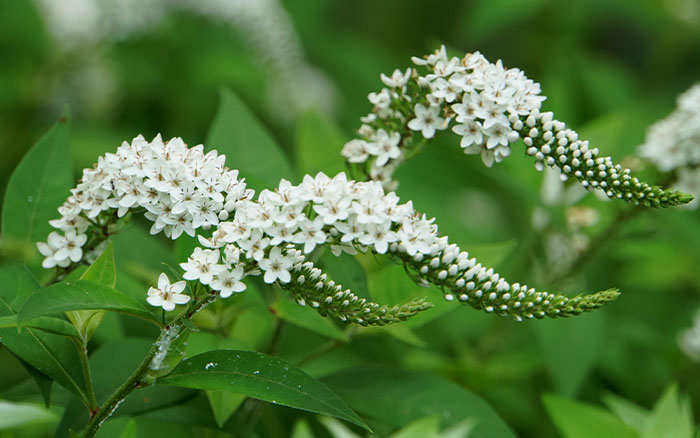A lovely herbaceous perennial to enjoy in your garden, Lysimachia clethroides is also easy to grow. Find out everything you need to know to grow this plant successfully.
Plant Biography

BOTANICAL NAME
Lysimachia clethroides
COMMON NAME
Gooseneck loosestrife, or just Gooseneck, or Chinese loosestrife.
NATIVE TO
Native to Southern Russia, Far East to Indo-China, and Temperate East Asia.
DESCRIPTION
This is a tall, herbaceous perennial. It has narrow, grey-green leaves, and produces white-grey flowers on their slender spikes in the summer.
What type of plant is it?
An herbaceous perennial.
What colours does Lysimachia clethroides come in?
Available in just its standard colour of whitish blooms, the silver-green foliage fades to a glorious amber in the autumn months.

When do these plants flower?
Lysminachia clethroides flowers between June and August, so you can enjoy their blooms all summer long.
Where does it like to grow?
Not a particularly fussy plant, Lysimachia clethroides will grow in moist but well-drained, or poorly draining soil. Ensure the soil is humus-rich too, and that your plant is in a fully sunny or partially shaded area.
Where does it dislike to grow?
Try to avoid growing in fully shaded areas, and in soil that will dry out too much in the summer months.
Is this plant drought-tolerant?
Lysmiachia clethroides has an average water requirement but is not drought tolerant. It will not cope in long, dry periods.
How to grow Lysimachia clethroides successfully
By giving your Lysimachia the right growing conditions, they should grow and spread readily in your garden. Simply ensure you give them humus-rich, moist soil and a sunny position.

Do they require supports?
Yes, the blooms of this plant may benefit greatly from some support. Bamboo canes or other forms of stakes may be all that is necessary to give some extra help to the 1-metre-tall stems to keep them upright.
Is it good for pollinators?
Yes, these plants are very pollen and nectar-rich, which is perfect for bees, butterflies, moths, and other pollinators. They are also good for encouraging other beneficial insects into the garden.

Is it good for wildlife?
This plant has no known benefits to garden wildlife besides pollinators and beneficial insects.
How to choose the right variety for your garden
Provided your garden has the right soil conditions, or you can add some organic matter like compost to boost the humus in the soil. The Lysimachia clethroides plant has the same conditions, and all other Lysimachia varieties will also cope well in the same conditions.

How big will it get
Typically, these plants will grow to a height and spread of 1 metre each.
How to plant Lysimachia clethroides
These are very easy plants to plant and grow. If growing from an established plant, simply position it into humus-rich and moist soil in a sunny spot. Make sure you give your Lysimachia plenty of room, as they tend to spread well.
How to care for Lysimachia clethroides
Make sure the soil for this plant stays consistently moist, and provide support for longer stems, particularly if they are struggling to stay upright.
Do they spread?
Yes, it readily spreads when given enough space. It spreads by clumps, which should be divided if you wish to control the spread. Lift and divide them in either spring or autumn, when the plants are in their dormant period.
How to keep it looking good
These herbaceous perennials don’t require much maintenance to keep them looking good. Divide them every two to three years so they don’t get too congested, and cut them back once the flowering period is over.

Does Lysimachia clethroides need deadheading?
The plant doesn’t require deadheading, but it will help to prolong the flowering period. So try to remove any spent flowers as they fade, unless you would like to let your plant go to seed.
Does it need pruning, and when should they be pruned?
The plant does not require pruning, but it should be cut back once the flowering period has finished at the end of the summer.
How to propagate these plants
There are a couple of ways. The most reliable and effective method would be to propagate by dividing and replanting the clumps of this herbaceous perennial. This can be done as often as every two to three years and should be done to limit the spread.
Otherwise, they can also be propagated by seed. You can do this by sowing outdoors in containers in the spring. And once they have produced established plants, you can plant them out into your garden borders.
What problems can Lysimachia clethroides have?
Generally, Lysimachia clethroides are quite trouble-free. The only pest you need to keep an eye out for, are slugs and snails. These can be deterred from your garden with some tactical planting choices.
I tend to find they are deterred from my garden beds where strongly-scented plants and herbs are present. For example, they are particularly averse to garlic, chives, rosemary and lavender, thanks to their particularly strong scents.
Also, I have had quite a lot of success growing Nasturtiums amongst my brassicas in my garden too, thanks to the peppery scent of these plants.
Varieties of Lysimachia clethroides to have
There is only one variety of Lysimachia clethroides, but there are several similar-looking varieties of Lysimachia.
Some have pink-white flowers, like Lysimachia ephemerum, whilst others, like Lysimachia atropurpurea ‘Beaujolais’ are a richer shade of pink. Or for a very striking display, Lysimachia ciliata ‘Firecracker’ boasts purple leaves which contrast wonderfully with the slightly yellowish blooms.



Best time of year to buy this plant
You can expect to buy these plants in garden centres year-round, but predominantly during their flowering season.

Leave A Comment